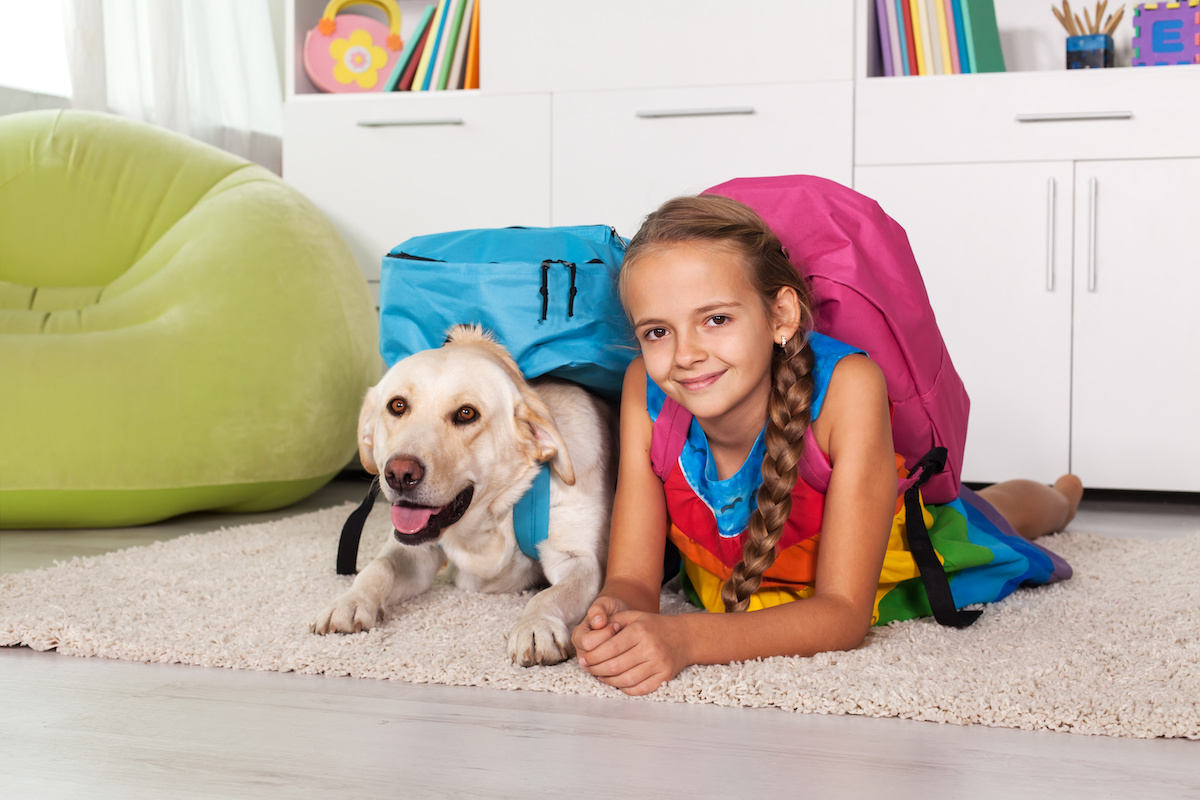Pets are part of the family. When it comes to kids, school aged children have a lot to benefit from a pet companion. Many kids have or want to have pets from a young age. In fact, 43% of kindergarteners have a dog at home. But what are the benefits of pets for school-aged children?
One surprising way to bolster a child’s development is to introduce a pet into their lives. As it turns out, the benefits of pets for school-aged children are extensive and well-documented.
A furry friend can help a child learn about responsibility, improve social skills, and even boost self-esteem. Let’s talk about why adopting a pet into your home is great for the kids, as well as the whole family.
Benefits of Pets: Learning Responsibility
With a pet comes a lot of responsibility. Having a cat or dog is a great way to instill responsibility in school-aged children. You can do so with the following tips.
Daily Routine
Owning a pet requires children to engage in daily care routines, such as feeding, walking, and grooming. This can instill a sense of responsibility and teach them the importance of regular habits and commitments.
Understanding Needs
By looking after a pet, children can learn how to recognize and cater to the needs of others. They quickly realize that their pet depends on them for food, shelter, and affection, which can help develop empathy.
Enhancing Social Skills
Pets and kids both benefit from interaction with one another. This partnership can enhance social skills and create a lifelong bond.
Bonding and Communication
Pets, especially dogs, can serve as excellent social companions. Interacting with them teaches children how to communicate, even if it’s in a non-verbal way. They learn to read body language, recognize emotions, and respond appropriately. This can help them develop social skills that will benefit them throughout their lives.
For example, a child who learns to read a dog’s body language will be better able to understand the feelings of other people. This can help them avoid conflict and build stronger relationships.
Meanwhile, children who learn to interact with pets learn empathy. They see how to take care of their pet and that their pet’s feelings matter. This can help them become more caring and compassionate adults.
Overall, pets can have a positive impact on children’s social development. They can teach children how to communicate, develop empathy, and learn responsibility.
Making Friends
Pets often serve as conversation starters, helping children connect with their peers who share an interest in animals. This can be particularly beneficial for shy kids, giving them a common topic to discuss and bond over.
Boosting Physical Health
Both pet and childhood obesity are problems that many families face. But children and pets can work together to boost physical health, staying in a healthy weight and living active lifestyles.
Exercise Through Play
Playing with a pet can be a great source of physical exercise for children. Whether it’s running around with a dog in the backyard or playing with a cat indoors, physical activity helps children stay fit and healthy. It can also help to reduce stress and anxiety, and promote better sleep. Additionally, playing with a pet can teach children responsibility and compassion.
Here are some of the benefits of playing with a pet:
- Promotes physical activity
- Reduces stress and anxiety
- Promotes better sleep
- Teaches responsibility and compassion
- Improves social skills
- Boosts self-esteem
- Provides companionship
Lastly, studies have shown that early exposure to pets can boost a child’s immune system, reducing their chances of developing allergies and asthma.
Improving Emotional Well-being
There’s no other type of love between a kid and their pet. This bond can help strengthen the emotional well-being of your child, which is critical during their developmental years. Here are the ways that a pet can further help improve your child’s emotional well-being.
Unconditional Love
Pets provide unconditional love and companionship, which can be particularly beneficial for children dealing with loneliness or emotional distress.
Building Confidence
The act of caring for another living being can boost a child’s self-esteem. Accomplishing tasks like training a pet or successfully taking on responsibilities helps them feel a sense of accomplishment and confidence.
Coping Mechanism
Pets can also serve as emotional support during tough times. The simple act of petting an animal can reduce stress, lower blood pressure, and promote feelings of calmness.

Learning Opportunities
Owning a pet offers children plenty of opportunities to learn. They can understand biological processes, discover different breeds and species, or even pick up a few training techniques.
Problem-Solving
Training and caring for pets often involve problem-solving. For instance, figuring out why a pet is behaving a certain way or learning how to teach a new trick can enhance a child’s problem-solving skills.
Teaching Your Child the Importance of Proper Pet Care
While there are plenty of benefits of pets for school aged-children, you’ll also want to teach them about proper pet care. As a parent, introducing a pet into your child’s life provides a perfect opportunity to teach them about proper pet care. This not only ensures the well-being of the pet but also instills valuable life skills in your child.
Responsibility and Compassion
- Explaining Pet Needs: Begin by explaining to your child that pets, just like humans, have needs. They require food, water, exercise, and affection to be healthy and happy.
- Involving Them in Care: Involve your child in daily pet care routines like feeding, grooming, and cleaning. This gives them a sense of responsibility and teaches them to be compassionate and attentive to others’ needs.
Respect and Boundaries
- Understanding Pet Behavior: Help your child understand that pets have their own personalities and boundaries. For example, some pets may not like to be held or petted all the time. Teach your child to recognize and respect these boundaries.
- Handling Pets Gently: It’s crucial to teach your child to handle pets gently and with care. Remind them that pets can feel pain and discomfort just like people can.
Pet Health and Hygiene
- Regular Vet Visits: Teach your child about the importance of regular vet checkups for their pet. Explain that just like humans go to the doctor, pets need to visit the vet to stay healthy.
- Maintaining Cleanliness: Encourage your child to keep the pet and its living area clean. This includes regular baths, cleaning the pet’s bedding, and picking up after the pet. Explain how this helps prevent illnesses and keeps the home environment healthy for everyone.
Training and Discipline
- Teaching Basic Commands: Get your child involved in training the pet to follow basic commands like sit, stay, or come. This teaches them about discipline and the importance of setting rules.
- Positive Reinforcement: Encourage your child to use positive reinforcement techniques during training. For example, rewarding the pet with treats or praise when it follows a command. Explain how this helps build a positive bond between them and the pet.
Benefits of Pets: Educating on Vet Care
Finally, teach your child that it’s important for pets to get an annual checkup from their doctor, just like they do. Annual vet checkups for dogs and cats can help prevent diseases or catch problems early.
If your cat or dog has yet to see a vet this year, please schedule an appointment with us today.






